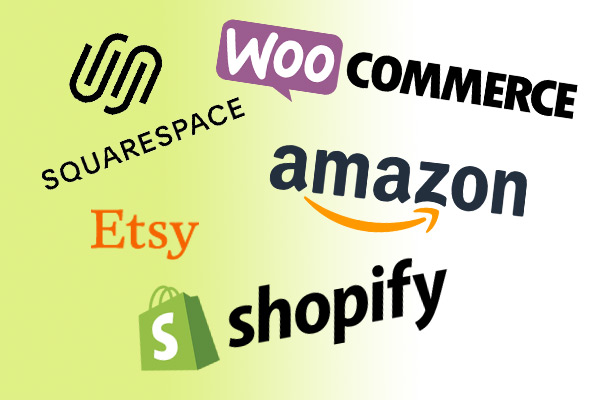One thing that the pandemic of 2020 has probably changed forever is the traditional trip to a brick and mortar store to browse the different departments and offerings. Now we’re much more likely to order exactly what we want in advance and spend just enough time in the store to pick it up. And without the ability to offer those products and services online and in advance probably means that we’ll lose that customer forever.
The great news for small businesses is that there’s never been a better time to setup and manage an online e-commerce component for their business – options abound and cater to all different types of business and different budget levels.

Having those choices however can lead to confusion on the part of the small business owner and confusion often leads to inaction. And unfortunately today, inaction can lead to a business being forced to close completely.
Here’s a quick guide to some of the options out there and a list of the potential pitfalls that fledgling e-commerce stores can face.
Amazon
The 800lb gorilla of e-commerce has become ubiquitous in everyday life – particularly when delivering those things we can’t live without and even those things we “think” we can’t live without! And while we think of it as one large corporation more than 50% of all Amazon sales come from 3rd party sellers. So if you’re looking to piggyback off a worldwide brand with a built-in infrastructure to sell your products would Amazon be a good bet?
The answer is maybe. Amazon does give a small business a tremendous opportunity to reach a wide audience, but that comes at a cost. Amazon charges what it calls a referral fee, typically 15% of the item’s price. It also charges fees for using “fulfillment by Amazon” which means that Amazon employees pick, pack & ship your products. There are also miscellaneous service fees. So you have to do your homework beforehand to make sure you’ll actually make money on what you’re selling.
This doesn’t take into account the cost of returns which can be very high and can be particularly punishing to small businesses.
Etsy
Etsy has become the go-to place for the arty/crafty products and services that we can’t buy from a traditional store. They have a very precise list of products that are allowed on the platform (handmade or vintage items primarily) so this option isn’t for everyone or every product.
Etsy charges a series of fees for selling on their platform: listing fees, transaction fees, shipping transaction fees, payment processing fees and more. These fees can add up quickly and can easily reach double-digits so again you have to make sure you can actually make money selling your product. And the fees can increase quite substantially if your store becomes very successful – Etsy, like Amazon, can and does change its policies and fee structure on a regular basis.
Squarespace
SS is primarily a do-it-yourself website building platform that on top of a range of “regular” website offers a series of e-commerce templates. You choose the template and fill in the product slots with your products and you’re pretty much ready to go. SS has hundreds of different templates to choose from and offers a one-stop shop for all the components you need to start selling including payment gateways, sales tax collection and help with shipping.
SS offers different plans each with a list of standard features that range in price from $12 to $40 per month, some of which include additional transaction fees and some that don’t.
The monthly fees are generally within most small business owners so is SS a good choice? Again the answer is maybe – there are two main disadvantages to using SS which should factor into whether it will work for you:
- It’s a closed, proprietary system which means that you are limited to whatever they provide you in the way of tools and extra functionality. This can be a limiting factor if your online business takes off and you want to expand beyond the basics.
- It’s designed to be a do-it-yourself platform. Is it a good use of your time to do it yourself? Paid assistance is available via 3rd parties who typically charge higher than the typical code-monkey because SS uses special code throughout its platform
Shopify
Shopify is very similar to Squarespace but without the regular websites – it’s strictly designed for building e-commerce sites. Again there are hundreds of templates to choose from and they take care of everything “under the hood” including payment, sales tax, etc.
The monthly fees are more expensive than with SS but you are getting a dedicated e-commerce solution that you can integrate with physical stores and point-of-sale systems.
The disadvantages described above for Squarespace apply to Shopify too – it’s a closed system and it’s a DIY platform. If you’re OK with this then Shopify can offer a lot of benefits to the start-up online business.
WooCommerce
If Amazon is the 800lb gorilla then WooCommerce is the sleeping giant of the e-commerce world. It’s owned by the people who make WordPress and it’s designed to seamlessly integrate with WordPress to present an easy-to-use e-commerce solution for small (and medium sized) businesses. WooCommerce has over 39 million downloads and is active on 3 million websites worldwide. It’s the single most popular e-commerce module in the world. And it’s free! Or at least free-ish – the core code is free but many of the hundreds of extensions available require payment.
WooCommerce is open-source software which means that the level of community support is high and additional functionality is being added all the time by developers from around the world. Once you have a basic WordPress installation up and running it’s possible to install one of a number of e-commerce store templates that come complete with all the software and tools you need to get an e-commerce store up and running quickly.
Because everything is contained within your own website all aspects of the process are under your control and other than credit card processing fees and shipping there are no additional fees or charges to be paid.
One strike against WooCommerce is that it almost tries too hard to be the solution to every possible e-commerce situation – it tries to cover every possible scenario and therefore can be complex to set-up and manage. The second big issue is that there’s really no central tech support center for WC – what’s available via the developer is limited and you’ll likely need expert help from a 3rd party to set the store up and keep it running in top condition.
Common E-commerce pitfalls for small business
Hopefully the info above has helped you select a suitable e-commerce platform for your business. Just before you rush off to challenge Jeff Bezos on the billionaire’s list here are some common pitfalls I’ve personally witnessed from clients setting up their online businesses:
- If you build it they will come!
 This is false. Just because you flick the switch and make your e-commerce site live to the world doesn’t mean that people will beat a path to your door. Successful e-commerce requires a significant investment in marketing to get people to come to your website in the first place. Whether it’s promoting your site on social media or in traditional printed materials, or whether you’re going to run pay-per-click campaigns on Google or Facebook – the need for marketing is real and is often overlooked by start-up entrepreneurs. The cost of customer acquisition is likely to be significant and needs to be taken into account.
This is false. Just because you flick the switch and make your e-commerce site live to the world doesn’t mean that people will beat a path to your door. Successful e-commerce requires a significant investment in marketing to get people to come to your website in the first place. Whether it’s promoting your site on social media or in traditional printed materials, or whether you’re going to run pay-per-click campaigns on Google or Facebook – the need for marketing is real and is often overlooked by start-up entrepreneurs. The cost of customer acquisition is likely to be significant and needs to be taken into account.
- “Hidden” costs. Aside from the cost of marketing there are a bunch of costs that need to be taken into account but that may not be so obvious from the outset. These include:
- Paying a web design company. Unless you really are going to do all this yourself, its likely that you’ll pay someone to build your site for you.
- Product photography. Whether you have 5 or 500 items to sell chances are that nobody will buy them if you don’t have professional photos (and possibly multiple photos of the same item) for every item.
- Data entry. For every item there’ll be a price and perhaps an SKU and maybe a weight or dimensions for shipping costs. Somebody will be responsible for adding all the data into your store and this can add substantially to the set-up costs.
- Website maintenance and hosting. As your site becomes more complex because of all the added functionality you’ve added so the cost of maintaining the site increases and if it really takes off then you’ll likely need more than a very basic shared hosting environment.
Remember that these could all be payable before you’ve actually even sold anything!
I hope this helps and if you have any questions about the available options please don’t hesitate to reach out to me at 973-234-5623 or via the contact form here.
